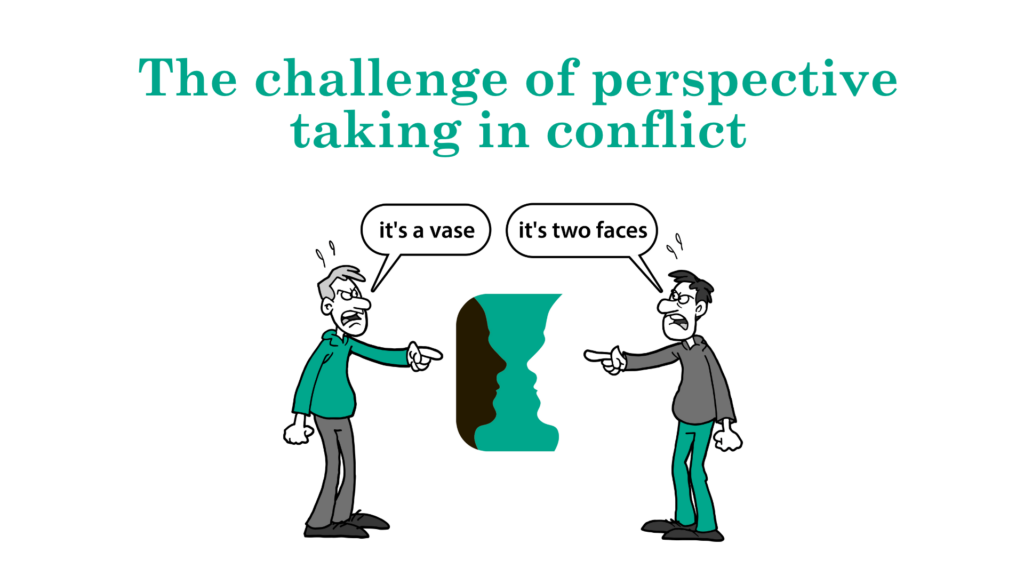It is generally accepted that, to successfully manage and resolve conflict, it is important to try to see things from perspectives other than our own. We are advised to “try to put yourself in the other person’s shoes” and to “look at the situation objectively”.
In theory, this is good advice, because our own point of view tends to be incomplete – what we notice and how we interpret it depends a great deal on our own personal experiences and current needs.
However, we are not very skilled at seeing things from other people’s perspectives, even with a concerted effort! Often, when we think we see things the way they see them, we are far from accurate. In conflict situations, we are less likely to be accurate, as our conflict-related emotions tend to get in the way of us seeing things differently.
As Nicholas Epley explains:
The benefit of perspective taking is obvious. You maximize your use of what you already know about another person, information that you might otherwise mistakenly overlook.
The weakness of perspective taking is also obvious: it relies on your ability to imagine, or take, the other person’s perspective accurately. If you don’t’ really know what it’s like… then the mental gymnastics of putting yourself in someone else’s shoes isn’t going to make you any more accurate. In fact, it might even decrease your accuracy.
When we try to take someone else’s perspective, we rely on information such as the other person’s facial expressions, body language, and what they say and do. We also take into account the context (physical and social factors that may give us clues as to what the other person might be seeing, thinking or feeling). However, our primary source of information is, counter-intuitively, to do with ourselves – our own prior experience with the other person, our own prior experience in similar situations, and what we are currently thinking and feeling.
There is a significant difference between
- Focusing on the other person’s situation as an observer (without trying to see it from their perspective);
- Imagining how you would feel if what was happening to the other person was happening to you;
- Imagining how the other person might think and feel given what is happening to them.
Frequently, our attempts at perspective taking only reach the second level.
To try to get closer to the third level, we must make a conscious effort to:
- Consider the similarities and differences between ourselves and the other person;
- Try to avoid projecting our own thoughts and feelings onto the other person;
- Try to imagine how the other person, given their current state of mind (so far as we can tell) might see the situation; and
- Imagine how the other person might think or feel about what is happening to them.
It is important to keep in mind that we can never be sure that our interpretation of another’s perspective is accurate. We may never be able to know what others truly think, feel or want.
However, the process of trying to take another’s perspective may still be useful as it:
- Requires us to consider what we know about the other person (and perhaps more importantly, what we don’t know);
- Reminds us that not everyone will see things the same way as we do;
- Motivates us to ask questions to find out more from the other person.
Also, it’s important to recognize that understanding another’s perspective does not necessarily resolve a conflict – sometimes it simply highlights that we see things very differently and that a strong disagreement exists.
I think Nicholas Epley’s words provide a perfect summary of this topic:
Others’ minds will never be an open book. The secret to understanding each other better seems to come not through an increase ability to read body language or improved perspective taking but, rather, through the hard relational work of putting people in a position where they can tell you their minds openly and honestly.
Useful reading about perspective-taking:
- Other minds: How humans bridge the divide between self and others, edited by Malle and Hodges, especially Chapter 2 “Three puzzles of mindreading” by Bertram E. Malle and Chapter 3 “A constituent approach to the study of perspective-taking: What are its fundamental elements” by Mark H. Davis.
- Mindwise: How we understand what others think, believe, feel and want, by Nicholas Epley.

